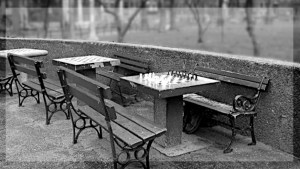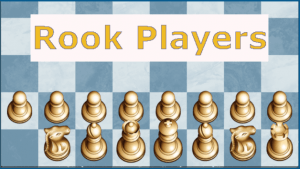The Dominican Order
|
The story is undoubtedly a bit of fiction but Panov captured the spirit of both Tschigorin and the famous Café Dominic.  Time passed much slower in those days. This 1887 sketch by Ilya Repin of Nevsky Prospect, probably doesn't differ much from what Tchigorin saw 14 years before.
 That same year, Repin, a regular at Dominic's, sketched a view inside the café. The original St. Petersburg Chess Club (Chess Lovers' Society) was formed in 1854 in the home of Count Alexander Grigorievich Kushelev-Bezborodko at 1-3 Gagarinskaya Street. Among it's members were Alexander Petoff, Ilya Shumov, Dmitri and Sergei Urusov, Carl Jaenisch, Viktor Mikailov, Ivan Butrimov, the chemist Dmitri Mendeleev. Many dignitaries visited the home for chess (some were possibly members) including the authors Ivan Tuegenev, Nikolai Akhsharumov, Leo Tolstoy, Mikhail Yevgrafovich Saltykov-Shchedrin, Dimitri Ivanovich Pisarev and Ivan Ivanovich Panaev, the poet Nikolay Alexeyevich Nekrasov, the composer Léon Fyodorovich Minkus, the Minister of War Prince Vasily Andreevich Dolgorukov and Ignatz Kolisch. One other member was the revolutionary Nikolay Gavrilovich Chernyshevsky whose presence there caused the club's demise in 1862, shut down by the police for suspicion of insurrection. In 1869 the club was reformed, though somewhat less formally in the huge building that covered 14-21 Officers' Street (now Dekabristov Street), by Ilya Shumov. This club included many of the original members such as Nikolay Ivanovich Petrovsky, G. F. Klements (one of the Klements brothers associated with Grigory Eliseev at whose home the original chess society met for a time) and M. S. Beskrovny, as well as A. I. Maksimov and P. A. Ponomarev. Petroff had died and Jaenisch would follow in a few years. The leading player was Shumov himself. The chess club gravitated to the Café Dominic in 1870 where a young Emmanuel Schiffers - he was born the same year as Tschigorin - started playing and soon equalled Shumov. When Tschigorin wandered into Dominic's in 1873, Schiffers was playing master-level chess and would be considered by many the strongest Russian player from 1873-1878. Although educated with a degree in Physics and Mathematics, he almost lived in the Café Dominic where he played for money and drinks. Schiffers was also an alcoholic, but still his contemporaries called him the "Teacher of Russian Chess." Like Fischer, he live to age 64.  [Рестораны Доминик - Dominic's Restaurant]
Although games played in the cafe were seldom recorded, this 1872 game between Shumov and Schiffers probably took place in Dominic's.
Calling the habituées of the Café Dominic Dominicans stems back to a newspaper cartoon even before chess caught on there. The Café was popular for many reasons. Dominic (or Dominik or Dominique) was opened by a Swiss gentleman named Dominic Ritz-a-Port (or Ritz Aport or Ritz á Port and even Ludwig Domenic Riz à Porta da Guarda from the municipality of Sarn in eastern Switzerland) in 1841. At that time Moscow and St. Petersburg maintained very strict rules set by Alexander I in 1821 for eating establishments and limited them to restaurants, hotels, coffee-houses, eating-houses and traktirs (tea-rooms) and each of these establishments were regulated scrupulously in what they could serve and how it could be served. Dominic Ritz-a-Port had to make a special proposal to the State Council for a dispensation, granted on April 11, 1841, to open what was termed a café-restaurant, a combination of a tavern, restaurant and coffee-house. Dominic's was licensed to sell: 1) A variety of beverages such as tea, coffee, chocolate, mulled wine and others. 2) Sweets and various cakes. 3) Bouillon, beefsteak and other snacks. 4) Various alcoholic liquids such as liquors, nalivka (a fruit liqueur), Russian and imported wines and beers. 5). Tobacco and cigars. It could also sell Russian and foreign newspapers permitted by the government and was permitted to rent space for billiards, bowling, dominoes, draughts and chess. How the food and drinks could be dispensed was also regulated. The special provision for café-restaurants required a special tax. Dominic Ritz-a-Port was a trained pastry chef and his pastry was his calling card. Among his most sought-after products was Kulebyaka (кулебяка), a savry seafood pie. This poem by Nikolai Agnivtsev describes a trio of Dominic's specialties (the poor tanslation is my own): Кулебяка «Доминика», Dominic's was opened in the building that adjoins St. Peter's Lutheran Church on Nevsky Prospekt. It's style and prices soon made it a favorite of students, white collar workers such as city officials, engineers and journalists, similar to the clinentele of the French cafés. It's said that the café became so popluar that for a time it served around 1,500 customers per day accounting for its smokey atmosphere. Its regulars included such individuals as the writers Dostoevsky, Saltykov-Shchedrin and Chekhov, the chemist Dmitri Mendeleev and the artist Ilya Repin. Part of the attraction, besides its breakfast, lunch and diner menus, was its buffet which featured sandwiches, pastry and even vodka and beer for one reasonable price. Dominic had barrels of Kalashnikov beer (made with products of the Kalashnikov Grain Exchange) in the cellar connected to two taps in the buffet area. Other similar establishments popped up in St. Petersburg and Moscow, but Dominic's was the most popular gathering place for chess players - so popular it became the venue for some of St. Petersburh's earliest tournaments. While the first tournaments held in 1874 and 1875 were minor ones and the venue unclear, in 1876 Dominic's hosted a four player tournament that included Shumov, Schiffers Tschigorin and Andreas Asharin (won by Asharin or Acharin, a German-Russian who worked as journalist for the "St. Petersburg Zeitung" and the "St. Petersburg Herald.") and a very limited three player tournament that included Tschigorin, Shumov and Schiffers with Schiffers and Shumov getting equal scores and Tschigorin losing. In 1877 another, larger, tournament was held. The venue isn't clear but most likely the Dominic. In this tournament Tschigorin won followed by followed by Emanuel Schiffers, Andreas Asharin, Hermann Clemenz, and Semyon Alapin. [Some sources differ about the above tournament data. The information above comes from the "Shakhmatny Listok" 1876 and 1877]
While the Café Dominic remained a place for chess players to meet, it's heydays were fading as the century approached its end. Vladimir Nikolayevich Yurevich, who beat Tschigorin in their first round game in the 1903 All Russian tournament in Kiev, played there as a teenager in the late 1880s on through the late 1890s, as did Sergei Lebedev. In fact both played in a 1898 minor tournament held at Dominic's.
The images below reflect the later days of the Café Dominic.  This painting of the inside of Dominic was created by Gugo Karlovich Bakmanson, also a chess player who came in 13th out of 14 competitors in the St. Petersburg Tournament of 1901. The following two turn-of-the-century photos sho the interior of Dominic.
  which appear to be part of this flyer project:   The above painting, U Dominika, by Vladimir Egorovich Makovsky, a contemporary of Schiffers, depicts the Café Dominique in 1910. |
Vasily Panov,


